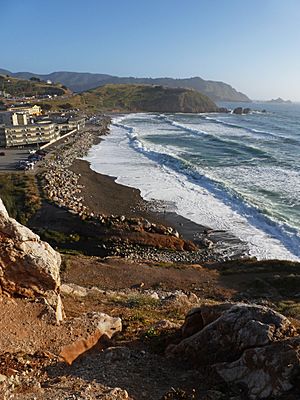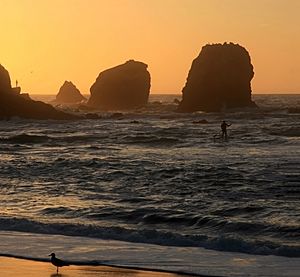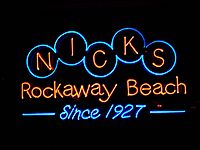Rockaway Beach, Pacifica, California facts for kids
Rockaway Beach is a beautiful beach area on the Pacific Ocean. It is located in the southern part of Pacifica, California, which is about 7 miles (11 km) south of San Francisco. You can easily reach it from Highway 1.
This beach is a popular spot with many restaurants and shops. Even though its size has shrunk a bit over the years due to erosion, it's still known for its amazing views. Many people consider it one of the cleanest beaches in the San Francisco Bay Area.
Contents
History of Rockaway Beach
There are no signs of ancient human settlements right at Rockaway Beach. However, a village of the Ohlone Native American people, called Timigtac, was located nearby. It was about half a mile away on Calera Creek, just east of Rockaway Beach near Highway 1.
Early Uses of the Area
The Rockaway Beach area has been important since the first Spanish explorers arrived. In 1776, the Portola Expedition explored this region. They are famous for discovering the San Francisco Bay.
People soon discovered that the Rockaway Quarry had a lot of limestone. This limestone was used to whitewash the new Presidio of San Francisco fort. Later, early homes in San Pedro Valley also used this limestone for their foundations.
Quarry and Railroad Development
In 1907, the Rockaway Beach quarry became a busy business run by the Stone Brothers. After the Ocean Shore Railroad was built in 1907, limestone from this quarry helped rebuild San Francisco. The city was recovering from the big 1906 San Francisco earthquake.
The quarry's materials were even used as a base for the railroad tracks. Because the railroad made travel easy, Rockaway Beach became like a suburb of San Francisco. But this changed when the railroad went out of business in 1921. This happened because of legal problems after a landslide damaged the tracks.
Modern Access and Quarry Closure
Highway 1 was finished from Montara to Rockaway Beach in 1937. This made it easy to get to the area from the north again. Horace Hill ran the quarry from the early 1940s to 1953. He also had a successful business digging for sand behind the quarry.
Later, different companies like Ideal Cement, Rhodes and Jamison, and Quarry Products owned the quarry. The quarry stopped working in 1987. Today (as of 2019), efforts are being made to make the old quarry stable and restore the land.
Natural Features of Rockaway Beach
The cliffs along the coast are very steep, some dropping almost straight down. Inside the quarry, the limestone rocks are hard and strong. They have cracks that are close together or far apart. Some of these rocks sit on top of "greenstone," which is a changed volcanic rock. This greenstone gets less worn out the deeper you go.
The eastern part of the quarry area has old river deposits underneath it. The sandy beach area is made of sand from a recent geological time. The amount of sand on the beach changes with the seasons. Winter waves can wash sand away, and summer waves slowly bring it back.
Plants and Habitats
The beach and the high areas (headlands) are mostly covered in California coastal prairie and northern coastal scrub plants. The area along Calera Creek has the most important natural habitat for land animals. Even though the beach and headlands are mostly untouched, people use them for fun activities.
Not many plants grow right on the beach. You might see juicy sea fig, Hottentot fig, and fat hen in the sandy spots. Farther from the beach, you can find bright California poppies, sand verbena, and tall bush lupines. The land near the ocean slowly gets higher towards the north, reaching a peak of 175 feet (53 meters).
The plants on the east-facing slope of the headland include northern coastal scrub. There's a lot of low-growing coyote brush, bush monkey flower, and groups of bush lupine. Many types of coastal wildflowers grow on these slopes. Besides California poppies, you can see goldenasters, Douglas iris, and many other native plants. The steep cliffs are home to plants that can handle wind and sea salt spray. These include silver beachweed, sea rocket, and large patches of yarrow.
Wildlife and Endangered Species
North of the main Rockaway Beach area is a hidden quarry. Its natural habitat has been greatly changed. Large rocks protect the developed area from ocean erosion. Near Calera Creek, you can find water plants like rushes, bulrushes, horsetail, fat hen, and plantain.
The quarry area is home to a surprising number of amphibians (like frogs), reptiles (like snakes), small mammals, and many different birds. You might see herons, egrets, California least terns, and red-winged blackbirds here. The cliffs within the quarry provide places for birds like bank swallows, pelagic cormorants, and Brandt's cormorants to build their nests.
Three endangered species live close to Rockaway Beach: the San Francisco garter snake, the San Bruno elfin butterfly, and the California red-legged frog. The butterfly and frog are found within the quarry property. The California red-legged frog is a very important food source for the San Francisco garter snake. These snakes are known to live on the Mori Point National Park land, which is right next to the quarry to the north.
Developed Area of Rockaway Beach
Right in the middle of Rockaway Beach, hugging the coast, is a group of restaurants and shops. The oldest of these is Nick's Seafood Restaurant, which is a famous spot in Pacifica. Another restaurant, once known as the romantic Moonraker, offers amazing night views. You can watch the Pacific Ocean waves crash against the strong walls protecting the restaurant. Newer shops are located behind the Moonraker. Many of these were built as part of the city's plan to improve the area in 1986.




